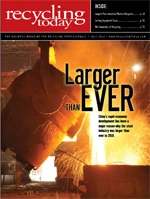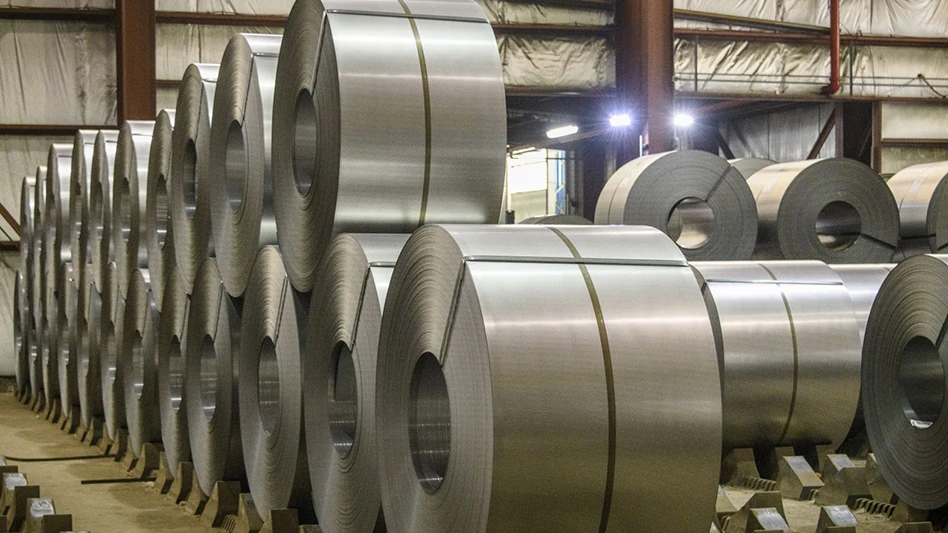Recyclers had numerous opportunities in the first half of 2011 to attend industry conferences and conventions to make new trading contacts, gather information and shop for the equipment that will prepare their commodities for future shipments.
Events taking place in the spring of 2011 included WasteExpo, the Bureau of International Recycling (BIR) World Recycling Congress and the Fourth China International Metal Recycling Conference.
The conferences also offered programs and sessions that provided updates on secondary commodity markets, processing techniques and forecasts on how the economy and basic materials industries might affect recyclers in the future.
 |
| Metals recyclers and producers gathered for the Fourth China International Metal Recycling Conference (upper left), which was held at the White Swan Hotel (lower left) in Guangzhou. Also held in May was WasteExpo 2011 (above) at the Dallas Convention Center. |
PLASTIC UPDATE AT WASTE EXPO
During the 2011 WasteExpo, held May 9-12 in Dallas, attendees at a session titled “Plastics Recycling Markets: Room for Growth” heard how demand for many post-consumer plastics is much greater than the supply being generated.
Tamsin Ettefagh, vice president of Reidsville, N.C.-based Envision Plastics, said Envision recycles high-density polyethylene (HDPE) and uses it to make post-consumer resins (PCR) that are used in packaging and other products.
Ettefagh remarked that even though the price for many types of PCR is greater than the cost of virgin material, Envision is still able to sell it.
Ettefagh gave her view that the quality of feedstock is diminishing partly because of single-stream programs that are not well-thought-out. New types of packaging or other materials coming into material recovery facilities (MRFs) also are contributing to quality issues, she said.
On the plus side, significant new demand is being by fueled by renewed “green” initiatives, corporate sustainability requirements and technologies that enhance properties of PCR, Ettefagh said.
Polypropylene (PP) is the plastic that is used the most in the world but is recycled the least, she said. She added that there is a large volume of the material—an estimated 17 billion pounds in North America, of which only 350 million pounds is being recycled. An estimated 2 billion pounds of PP is being used in what Ettefagh described as short-lived products. PP is an area of growth in the secondary plastic market, demonstrated by the fact that in just two years’ time prices for it have doubled, Ettefagh said.
Other post-consumer plastics also are experiencing a high level of demand. Matt Hardymon of Custom Polymers PET, Athens, Ala., told attendees of the session that his company is getting 240 potential buyer leads per month and that the company’s supply of recycled PET (polyethylene terephthalate) cannot keep up. “We need to collect more,” he said.
He estimated that 27 percent of PET bottles are being recycled in the U.S, adding that in order to meet current demand, that recycling rate needs to double.
| JAPAN’S RECYCLERS REBUILD, PITCH IN |
| Tsunefumi Nakatsuji, president of the Japan Iron & Steel Recycling Institute (JISRI), expressed his “heartfelt thanks” to delegates at the Fourth China International Metal Recycling Conference “for your letters of condolences and encouragement to those of us in Japan since the tragedies of the East Japan Earthquake on March 11.” At the event in Guangzhou, China, Nakatsuji provided an update to attendees on the cleanup and rebuilding process in the earthquake zone as well on Japan’s overall ferrous scrap and steelmaking industries. The earthquake and tsunami had claimed more than 13,000 lives with another 14,000 people still listed as missing, Nakatsuji said. Also, some 137,000 people in the six affected prefectures have had to be evacuated from their homes, he noted. “Some of the recycling facilities of JISRI member companies were heavily damaged by the earthquake and tsunami,” Nakatsuji noted, “but they have been quickly recovering and cleaning up their scrap yards and repairing their machines so that they can contribute to the recycling of the huge amount of scrap resulting from the damage.” Nakatsuji estimated “the total volume of scrap [metal] resulting from these tragedies is reported to be 1 to 2 million [metric] tons.” The subsequent reactor building explosions at the Fukushima nuclear power plant have caused widespread health concerns as well as concerns in the international scrap market about radiation levels in scrap shipped out from the Fukushima region. Nakatsuji noted after the radiation problems took place, Japanese and Korean steel mills set an identical acceptable maximum radiation level while China’s customs agency set a more strict level. “JISRI has suggested that an international standard for the radiation safety [for] recycling scrap must be discussed and agreed upon among all the nations of the world in order to avoid problems at future times of crisis,” Nakatsuji said. Japan’s steel industry has been rebounding since what Nakatsuji referred to as the “Lehman Shock” of 2008. In 2010, the country produced nearly 110 million metric tons of steel. Only about 22 percent of that total (23.8 million metric tons) was made with the scrap-intensive electric arc furnace (EAF) process, he noted. However, basic oxygen furnace (BOF) steelmakers in Japan were melting more scrap than they used to, Nakatsuji said. “Since the early 2000s, the scrap usage ratio [at Japanese BOF mills] has been raised from the prior 6 to 7 percent to 12 to 14 percent,” he commented. Japan has available scrap for these BOF buyers and still generates enough to export some 5 million tons annually to China, South Korea and other nations. The Fourth China International Metal Recycling Conference, organized by the Metallurgical Council of the China Council for the Promotion of International Trade (MC-CCPIT), was held May 13-14, 2011, in Guangzhou, China. |
BIR: SCRAP METAL’S ESCALATING VALUE
At the Nonferrous Division Meeting at the 2011 Bureau of International Recycling (BIR) World Recycling Congress, division president Robert Stein of Alter Trading, St. Louis, asked guest speakers to consider whether copper has become “the next gold.”
Stein pointed to “the startling way in which this metal has displayed its resilience to economic disaster,” adding, “No industrialized economy on Earth can do without it; it is a vital ingredient in infrastructural growth and it attracts attention almost unknown among its base metal counterparts.”
Beyond its industrial demand, Stein said of copper, “The commodity has been financialized to a much higher degree than ever as the investment community continues to use the metal as a source of leveraged speculation.”
Guest speaker Christian Schirmeister of J.P. Morgan Metals, London, noted copper inventories had been building in China. “It will take some time, but these stocks will find their ways to consumers,” he remarked.
Schirmeister did not express alarm about the increased use of ETFs (exchange-traded funds) as a way to invest in copper and said the “financial sector still does not replace underlying physical supply and demand” as the main factors in copper pricing.
Speaker Glen Gross of Wimco Metals, Pittsburgh, was not as convinced, referring to fund investors in the copper market as “ghosts that haunt and influence our daily business.” Gross said, “They are the unseen financial flows that regularly rocket and torpedo our markets. Today, because of these ghosts, I find that markets act the opposite of what our brains tell us. Managing risk seems to consume an inordinate amount of our time, and has created the most challenges.”
Guest speaker Miguel Garcia of Spain’s LaFarga Lacambra gave the point of view of a red metal scrap consumer. “The markets for raw materials follow a cyclical model based on supply and demand,” he commented. “In the 21st century, the sharp increase in demand had as an effect a tripling of the prices of [red] metals between 2002 and 2008.”
Recyclers and scrap consumers are poised to benefit from the “scarcity of natural resources,” Garcia said. “The recycling of raw materials will become an important industrial activity. A world market for ‘green’ products and services is expected to double [in revenue] from 2011 to 2020.”
Several scrap companies combined to sponsor hedge-fund manager, author and frequent financial commentator Jim Rogers as the guest speaker at the BIR’s Ferrous Division meeting.
During his presentation and as he answered questions afterward, Rogers made clear his opinion that producers of basic materials and holders of raw materials would play a pivotal role in the global economy in the next 10 years.
Although petroleum scarcity may be the most prominent example of why natural resources and raw materials markets will be bullish, Rogers said, “The supply of nearly all raw materials is declining at a time when demand is going up. It’s why raw materials are now in a bull market that will go on for some time.”
Speaking to his audience of metals recyclers, Rogers added, “You’re in the right place at the right time. You guys, everybody loves—they love what you do. You’re not evil financiers.”
Rogers noted that in the 1950s, ’60s and ’70s, manufacturers and raw materials companies were “in charge.” However, starting in the 1980s through 2008, “Wall Street was in charge—but that’s finished.”
He said he would tell young people today not to pursue an MBA but instead urge them to “get a farming degree or a mining degree or go to work on one of your trucks.”
China’s production and consumption of steel and other raw materials has been a major factor and will continue to be, Rogers said. He was not as optimistic, however, about India developing along the same lines.
Rogers called India “an astonishing country to visit” but “as a place to invest, it’s a nightmare.” He cited as his concerns too much bureaucracy, too much debt and an overriding anti-capitalist sentiment in the nation.
The steel and ferrous scrap industries may be tied into a “raw materials bubble,” Rogers said, but it is not a bubble he sees popping until perhaps 2018 or 2020. “Please watch for signs of a bubble,” he told BIR attendees. “When you
come to one of these meetings and everyone is talking about how smart they are, leave the room and sell.”
The 2011 BIR World Recycling Congress was May 23-25 at the Shangri-La Hotel in Singapore.
CHINA’S BUSY METAL RECYCLERS
The Fourth China International Metal Recycling Conference opened May 13 with a series of presentations from Chinese government officials from several departments and agencies.
The event, organized by the Metallurgical Council of the China Council for the Promotion of International Trade (MC-CCPIT), was held May 13-14, 2011, in Guangzhou, China. Its first four speakers represented Chinese central government agencies. Each official spoke about changes he or she saw being made China in regards to metal recycling.
Among them, Li Jing of the Department of Resource Conservation and Environment Protection, said recycling was a natural fit with Beijing’s Circular Economy initiative.
She indicated that departments such as hers were preparing to make “technical improvements in recycling technology” easier for recyclers. She also said national agencies such as hers were becoming mindful of adopting policies that were “more in line with regional and local considerations,” rather than expecting recyclers to operate uniformly in all parts of the country.

Explore the July 2011 Issue
Check out more from this issue and find your next story to read.
Latest from Recycling Today
- Fitch Ratings sees reasons for steel optimism in 2025
- P+PB adds new board members
- BlueScope, BHP & Rio Tinto select site for electric smelting furnace pilot plant
- Magnomer joins Canada Plastics Pact
- Out of touch with reality
- Electra names new CFO
- WM of Pennsylvania awarded RNG vehicle funding
- Nucor receives West Virginia funding assist





